VAUXHALL MOVANO_B 2016.5 Manual PDF
Manufacturer: VAUXHALL, Model Year: 2016.5, Model line: MOVANO_B, Model: VAUXHALL MOVANO_B 2016.5Pages: 239, PDF Size: 5.64 MB
Page 71 of 239
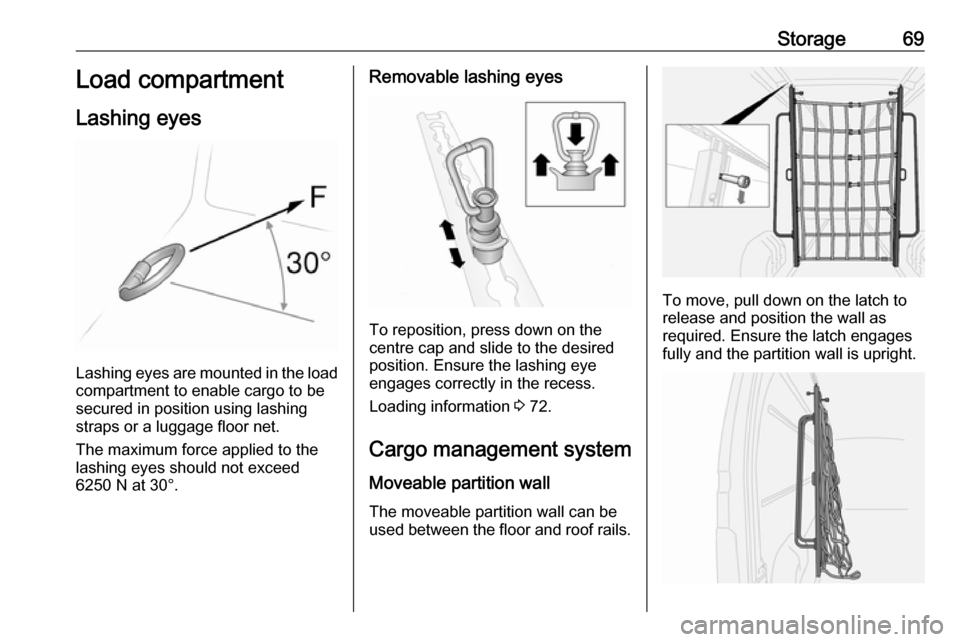
Storage69Load compartment
Lashing eyes
Lashing eyes are mounted in the load
compartment to enable cargo to be
secured in position using lashing
straps or a luggage floor net.
The maximum force applied to the
lashing eyes should not exceed
6250 N at 30°.
Removable lashing eyes
To reposition, press down on the
centre cap and slide to the desired position. Ensure the lashing eye
engages correctly in the recess.
Loading information 3 72.
Cargo management system
Moveable partition wall
The moveable partition wall can be
used between the floor and roof rails.
To move, pull down on the latch to release and position the wall as
required. Ensure the latch engages
fully and the partition wall is upright.
Page 72 of 239
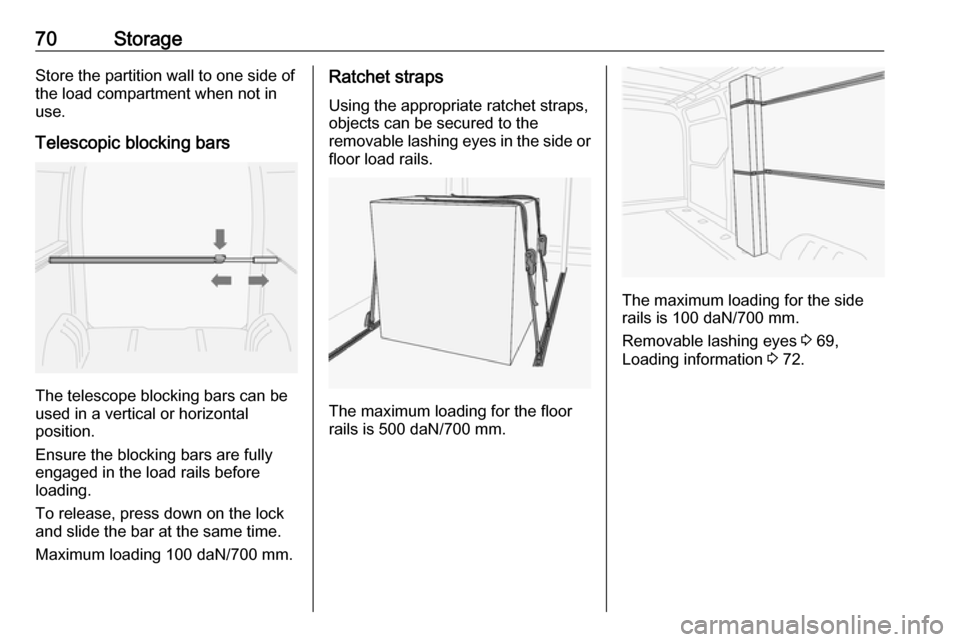
70StorageStore the partition wall to one side of
the load compartment when not in
use.
Telescopic blocking bars
The telescope blocking bars can be
used in a vertical or horizontal
position.
Ensure the blocking bars are fully
engaged in the load rails before
loading.
To release, press down on the lock
and slide the bar at the same time.
Maximum loading 100 daN/700 mm.
Ratchet straps
Using the appropriate ratchet straps,
objects can be secured to the
removable lashing eyes in the side or
floor load rails.
The maximum loading for the floor
rails is 500 daN/700 mm.
The maximum loading for the side
rails is 100 daN/700 mm.
Removable lashing eyes 3 69,
Loading information 3 72.
Page 73 of 239
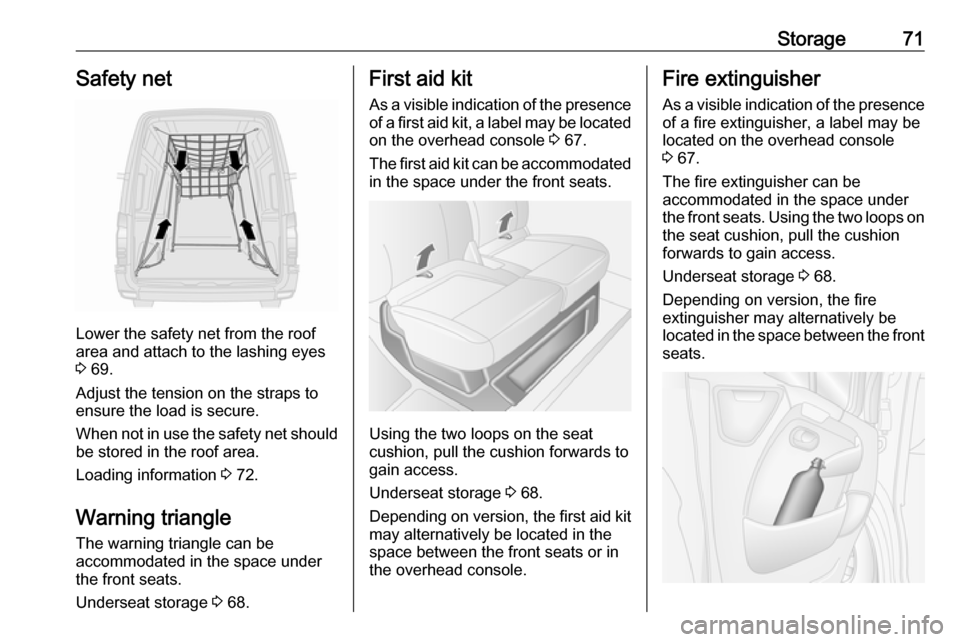
Storage71Safety net
Lower the safety net from the roof
area and attach to the lashing eyes
3 69.
Adjust the tension on the straps to
ensure the load is secure.
When not in use the safety net should be stored in the roof area.
Loading information 3 72.
Warning triangle
The warning triangle can be
accommodated in the space under
the front seats.
Underseat storage 3 68.
First aid kit
As a visible indication of the presence
of a first aid kit, a label may be located on the overhead console 3 67.
The first aid kit can be accommodated
in the space under the front seats.
Using the two loops on the seat
cushion, pull the cushion forwards to
gain access.
Underseat storage 3 68.
Depending on version, the first aid kit may alternatively be located in the
space between the front seats or in
the overhead console.
Fire extinguisher
As a visible indication of the presence
of a fire extinguisher, a label may be
located on the overhead console
3 67.
The fire extinguisher can be
accommodated in the space under
the front seats. Using the two loops on the seat cushion, pull the cushion
forwards to gain access.
Underseat storage 3 68.
Depending on version, the fire
extinguisher may alternatively be
located in the space between the front
seats.
Page 74 of 239

72StorageAn additional fire extinguisher may be
located in the front door panel or in the load compartment.Roof rack system
Roof rackFor safety reasons and to avoid
damage to the roof, the vehicle
approved roof rack system is
recommended.
Follow the installation instructions
and remove the roof rack when not in
use.Loading information
● Heavy objects in the load compartment should be evenlydistributed and placed as far
forward as possible. If objects
can be stacked, the heavier
objects should be placed at the
bottom.
● Secure objects with lashing straps attached to lashing eyes
3 69.
● Secure loose objects in load compartment to prevent themfrom sliding.
● The load must not obstruct the operation of the pedals, parking
brake and gear selector lever, or
hinder the freedom of movement of the driver. Do not place any
unsecured objects in the interior.
● Do not drive with an open load compartment. In addition, the
number plate is only
distinguishable and illuminated
correctly if the doors are closed.
Page 75 of 239

Storage739Warning
Always make sure that the load in
the vehicle is securely stowed.
Otherwise objects can be thrown
around inside the vehicle and
cause personal injury or damage
to the load or vehicle.
● The payload is the difference between the permitted gross
vehicle weight (see identification
plate 3 204) and the EC kerb
weight.
To calculate the payload, enter
the data for your vehicle in the
Weights table at the front of this
manual.
The EC kerb weight includes
weights for the driver (68 kg),
luggage (7 kg) and all fluids (fuel
tank 90% full).
Optional equipment and
accessories increase the kerb
weight.
● Driving with a roof load increases
the sensitivity of the vehicle to
cross-winds and has a
detrimental effect on vehicle
handling due to the vehicle's
higher centre of gravity.
Distribute the load evenly and secure it properly with retaining
straps. Adjust the tyre pressure
and vehicle speed according to
the load conditions. Check and
retighten the straps frequently.
Do not drive faster than 75 mph.
● The permissible roof load (which includes the weight of the roof
rack) is 200 kg for standard roof
variants. The roof load is the combined weight of the roof rack
and the load.
Page 76 of 239

74Instruments and controlsInstruments and
controlsControls ....................................... 75
Steering wheel adjustment ........75
Steering wheel controls .............75
Horn ........................................... 75
Steering column controls ...........75
Windscreen wiper/washer .........76
Outside temperature ..................77
Clock ......................................... 77
Power outlets ............................. 78
Cigarette lighter ......................... 78
Ashtrays .................................... 79
Warning lights, gauges and indi‐ cators ........................................... 79
Instrument cluster ......................79
Speedometer ............................. 79
Odometer .................................. 80
Trip odometer ............................ 80
Tachometer ............................... 80
Fuel gauge ................................ 80
Engine coolant temperature gauge ....................................... 81
Engine oil level monitor .............81
Service display .......................... 82
Transmission display .................82Control indicators ......................83
Turn signal ................................. 86
Seat belt reminder .....................86
Airbag and belt tensioners .........86
Airbag deactivation ....................86
Charging system .......................87
Malfunction indicator light ..........87
Service vehicle soon .................87
Stop engine ............................... 88
Brake system ............................. 88
Antilock brake system (ABS) .....88
Upshift ....................................... 88
Lane departure warning ............88
Electronic Stability Program ......89
Electronic Stability Program off ............................................. 89
Engine coolant temperature ......89
Preheating ................................. 89
AdBlue ....................................... 89
Tyre pressure monitoring system ...................................... 89
Engine oil pressure ....................90
Low fuel ..................................... 90
Stop-start system ......................90
Exterior light .............................. 91
High beam ................................. 91
High beam assist .......................91
Fog light ..................................... 91
Rear fog light ............................. 91
Cruise control ............................ 91Tachograph............................... 91
Door open .................................. 91
Information displays .....................92
Driver Information Centre ..........92
Info display ................................ 92
Vehicle messages ........................92
Warning chimes .........................93
Trip computer ............................... 94
Tachograph .................................. 96
Page 77 of 239
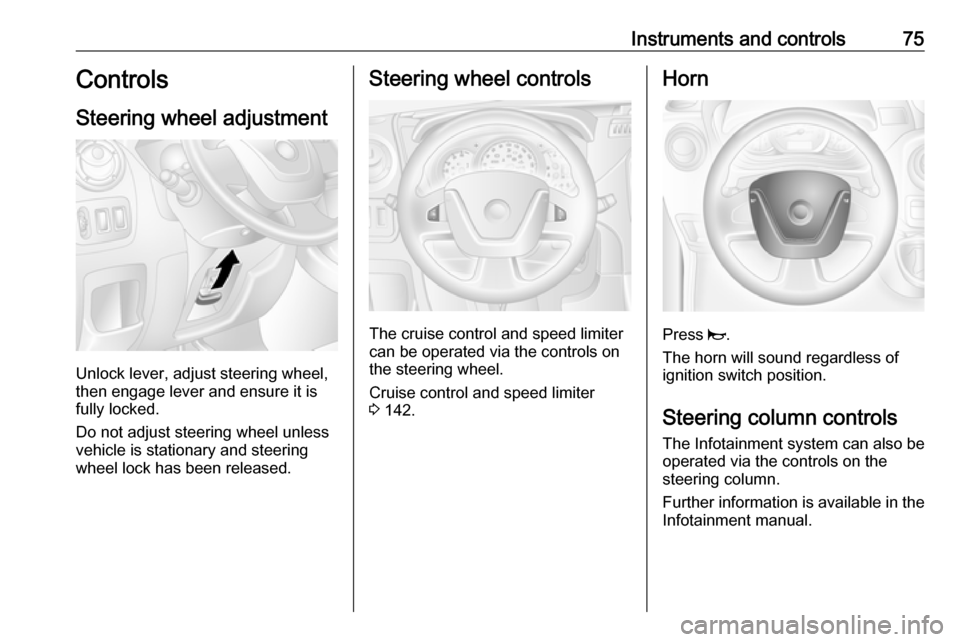
Instruments and controls75Controls
Steering wheel adjustment
Unlock lever, adjust steering wheel,
then engage lever and ensure it is fully locked.
Do not adjust steering wheel unless
vehicle is stationary and steering
wheel lock has been released.
Steering wheel controls
The cruise control and speed limiter
can be operated via the controls on
the steering wheel.
Cruise control and speed limiter
3 142.
Horn
Press j.
The horn will sound regardless of
ignition switch position.
Steering column controls The Infotainment system can also be
operated via the controls on the
steering column.
Further information is available in the
Infotainment manual.
Page 78 of 239
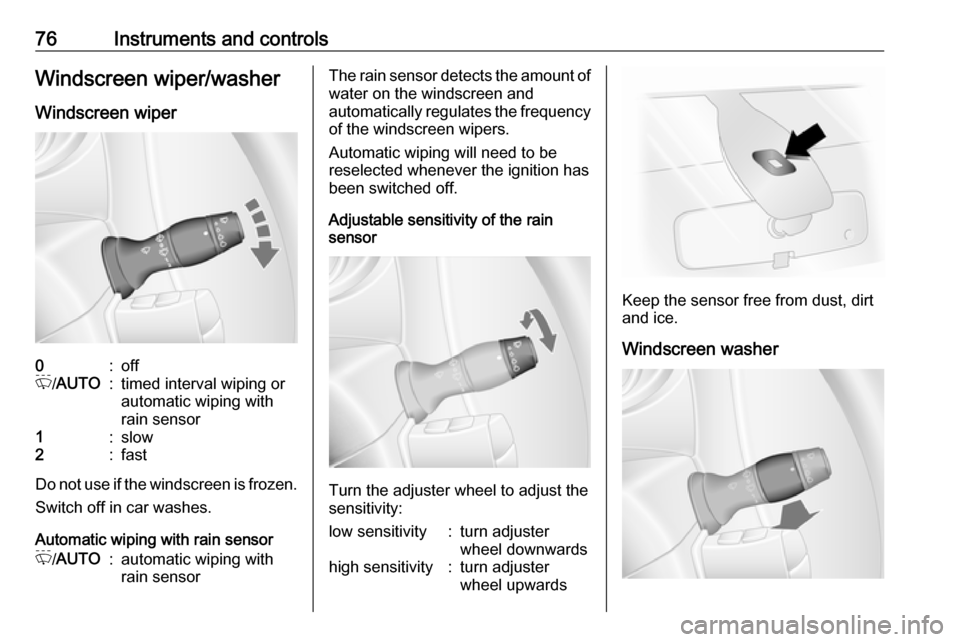
76Instruments and controlsWindscreen wiper/washerWindscreen wiper0:offP /AUTO:timed interval wiping or
automatic wiping with
rain sensor1:slow2:fast
Do not use if the windscreen is frozen.
Switch off in car washes.
Automatic wiping with rain sensor
P /AUTO:automatic wiping with
rain sensorThe rain sensor detects the amount of water on the windscreen and
automatically regulates the frequency
of the windscreen wipers.
Automatic wiping will need to be
reselected whenever the ignition has
been switched off.
Adjustable sensitivity of the rain
sensor
Turn the adjuster wheel to adjust the
sensitivity:
low sensitivity:turn adjuster
wheel downwardshigh sensitivity:turn adjuster
wheel upwards
Keep the sensor free from dust, dirt
and ice.
Windscreen washer
Page 79 of 239

Instruments and controls77Pull lever. Washer fluid is sprayed
onto the windscreen.short pull:wiper swipes oncelong pull:wiper swipes for a few
strokes
Outside temperature
A drop in temperature is indicated
immediately and a rise in temperature
after a time delay.
If outside temperatures drop to 3 °C, the °C flashes in the information
display as a warning for icy road
conditions. This will continue to flash until temperatures rise above 3 °C.
9 Warning
The road surface may already be
icy even though the display
indicates a few degrees above 0
°C.
Clock
Depending on vehicle, the current
time and/or date may appear in the information display 3 92 or the
Driver Information Centre (DIC)
3 92.
Set time and date in information
display
Hours and minutes can be adjusted
by pressing the appropriate buttons
by the display or with the Infotainment
system controls.
Further information is available in the
Infotainment system manual.
Set time in DIC
Display the clock function by pressingbutton repeatedly on end of wiper
lever. When the time flashes (after
approx. 2 seconds):
● Press and hold the bottom button.
● Hours flash.
Page 80 of 239
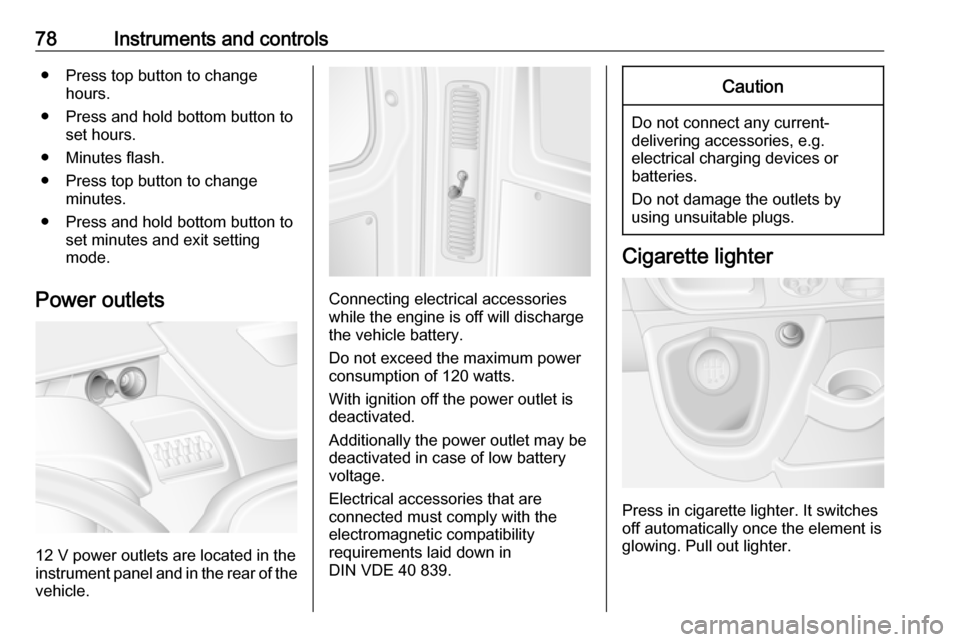
78Instruments and controls● Press top button to changehours.
● Press and hold bottom button to set hours.
● Minutes flash.
● Press top button to change minutes.
● Press and hold bottom button to set minutes and exit setting
mode.
Power outlets
12 V power outlets are located in the instrument panel and in the rear of the
vehicle.
Connecting electrical accessories
while the engine is off will discharge
the vehicle battery.
Do not exceed the maximum power consumption of 120 watts.
With ignition off the power outlet is deactivated.
Additionally the power outlet may be
deactivated in case of low battery
voltage.
Electrical accessories that are
connected must comply with the
electromagnetic compatibility
requirements laid down in
DIN VDE 40 839.
Caution
Do not connect any current- delivering accessories, e.g.
electrical charging devices or
batteries.
Do not damage the outlets by
using unsuitable plugs.
Cigarette lighter
Press in cigarette lighter. It switches
off automatically once the element is
glowing. Pull out lighter.